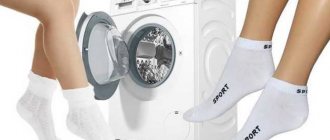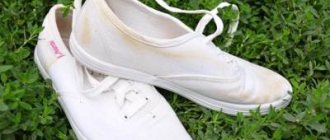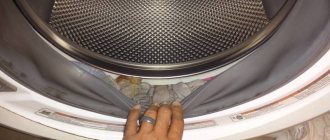0 /5
20.11.2021
197
White socks are an indispensable element of almost any wardrobe, both men's and women's. However, caring for them can cause a lot of difficulties, since the white material gets dirty quickly and is not always cleaned after regular washing. Let's look at the features and methods of cleaning even the most dirty and worn white socks.
Why white socks get dirty quickly: the main reasons
White socks are in direct contact with the floors, so questions about why they quickly get dirty and dirty usually do not arise. However, even if you mop and vacuum your floors every day, your socks can still quickly turn gray and look less neat.
The following reasons may contribute to their rapid contamination
Dirty insole and inner walls of shoes. Especially new shoes often leave dark marks on the toes.- Increased sweating of the feet. Then the white socks will become dirty inside and out, even if you haven't worn them anywhere. In addition to changing the shade of the material, it also absorbs the unpleasant odor of sweat.
- Stains and dirt. Mechanical dirt also often remains on socks and is difficult to wash off, since they are quickly absorbed into the fibers of the fabric while walking.
The reason why your white socks quickly get dirty depends not only on how to clean them, but also on preventative measures that will help keep them in their original condition longer and avoid changes in shade.
Preparation for the process
Before you start washing your socks, you need to prepare them. This stage includes the following actions:
Sorting. Black, colored and white items are washed separately.- Remove any large debris from the sole, such as adhered pet hair or hair. This is easy to do with a clothes cleaning adhesive roller.
- Turn the pair inside out. Sand often accumulates inside, and stones and other small debris can get in.
If the socks are new and are being washed for the first time, you need to read the recommendations given by the manufacturer. They are indicated on the label.
Sometimes soaking is required before washing . This procedure allows you to get rid of stubborn dirt and yellowness. To enhance the effect, you can use stain remover and bleach (it is used for white things).
The duration of soaking is from 1 to 12 hours. The socks of people suffering from nail fungus must undergo this procedure.
You can soak products using the “dry” method. To do this, they are slightly moistened, soaped, placed in a plastic bag and left overnight. In the morning, the pair should be lightly rubbed and rinsed thoroughly.
General recommendations
Despite the fact that it seems that there is nothing difficult in washing white socks, not everyone manages to maintain their original snow-white shade for a long time.
Wash your socks immediately after wearing them. There is no need to hoard them and put aside a soiled pair of white socks until the next wash, because over time, dust and dirt eat into the fibers, and it will be much more difficult to clean them.
When washing in a machine, add 2-3 tennis balls to the drum. This will ensure constant friction of the material being washed and will increase the washing efficiency. This way you can create an automatic semblance of manual rubbing of socks.
Wash white socks only with white laundry. Do not mix them with colored or black clothes, so that the fabrics being washed do not fade and discolor the snow-white color.
Before washing, turn your socks inside out. Also, clean them of all debris and hair before putting them in the drum.
Before washing, be sure to wash and soak your white socks for at least a few minutes. Such actions will help remove all dirt and stains, even stubborn ones, and preserve the brightness of the color longer.
You only need to dry your socks naturally. Do not place them in direct sunlight or near heating sources if you do not want them to turn yellow and lose their previous shape.
Wash your socks in fabric bags. This advice applies more to shortened socks, which can accidentally get caught in the mechanisms of the washing machine and ruin it.
Traditional methods
At home, you can easily restore your socks to their former snow-white color using acetylsalicylic acid tablets. For 1 liter of water at room temperature you will need 2-4 tablets, depending on the degree of contamination. They are thoroughly pounded and mixed with water, and socks are placed. Exposure time from 2 to 6 hours.
To remove not very old stains, you will need a tablespoon of ammonia diluted in 1 liter of water. Place the socks for 2 hours; for more complex stains, it is recommended to extend the soaking time for another 8 hours.
Hydrogen peroxide will help restore the former whiteness of your socks at home. It is allowed to be used for all types of fabric. 2 tbsp. spoons of hydrogen peroxide are diluted with 3 liters of water. Soaking time - 1 hour. To improve the effect, you can add 1 tbsp. l. ammonia.
Boric acid is suitable for removing stains. It is even suitable for soaking wool socks. For 5 liters of water you will need 10 g of acid. Exposure time – 1.5 hours.
How to get rid of smell from socks?
Often, rapid soiling of socks is accompanied by the appearance of an unpleasant odor, which can remain on the fabric even after normal washing.
To avoid discomfort associated with unpleasant odor on socks, follow the recommendations:
Use shoe deodorant. It works like a regular body antiperspirant and blocks unpleasant odors.- Wash your feet before putting on socks.
- Check the functioning of the gastrointestinal tract and digestive systems. Often, increased sweating of the feet and the appearance of a corresponding odor are associated with problems in the body.
- Buy shoes made from natural materials (fur, leather, suede, etc.). Artificial and synthetic fabrics often cause foot irritation and an unpleasant odor.
- When washing, add conditioner to the machine. This way your socks will initially have a pleasant aroma that will last until the next wash.
By following the described rules, you can not only eliminate the unpleasant odor, but also prevent its occurrence, prolonging the freshness of your socks.
Drying time
You will be surprised to know that even socks can be dried incorrectly! The best option for them is on clothespins in the fresh air - as in the photo. But dry hot heat in dryers and radiators will lead to thinning of the threads. It is best to dry woolen socks in a horizontal position, on a spread cloth or towel, and it is not advisable to even wring out those knitted from angora or mohair before doing this.
It's wash compatible - what do you think?
If you urgently need to dry your socks, you can resort to one of the following methods:
- Having covered the socks at the bottom and top with a cotton cloth, iron them with an iron heated to maximum temperature. It is important to deactivate the steam.
- Hang wet socks on a running fan - to secure them, you can use the same clothespins for socks for washing in the washing machine drum.
- For extreme sports enthusiasts - a microwave. However, it is not advisable to dry white socks this way - not completely rinsed detergents can bake unsightly rusty patterns on the fabric.
Advice! One of the available means of preventing fungal diseases is periodic ironing of cotton and synthetic socks.
Applications of one clothespin
How to keep socks white after washing?
There are general recommendations for caring for socks:
- Wear them only on clean feet. Even if you walk a little on a less than clean floor, be sure to rinse your feet and only then put on socks.
- Change the insole. A clean insole in your shoes is the key to clean socks. You can even buy a universal insole and switch it between different pairs of shoes.
- Dry your socks only naturally. Do not hang them in direct sunlight or on heating devices to avoid yellowing.
- Wash your socks after every wear. Don't re-wear them or put aside a worn pair until your next wash.
- Do not store socks with underwear of a different color. If they are in a common drawer with socks and tights, additionally pack them in a separate bag so that they do not turn a different shade. It is especially important to follow this rule before washing - do not put white socks in a common basket with laundry, allocate another place for them.
By following all the tips, you can not only wash your white socks quickly and effectively, but also keep them in that condition for a long time.
About thermal socks
There is no better product for athletes, tourists, lovers of an active life, and simply for everyday wear, especially in cold weather, than thermal socks. They reduce friction when walking, remove moisture from the skin, and maintain comfortable warmth and dryness. And, again, it is incorrect washing that will deprive these wonderful socks of their wonderful properties, turning them into ordinary hosiery. To prevent this from happening to your property, follow the recommendations from the table on how to wash thermal socks:
Socks that are not very dirty can be washed anyway
| Type of wash | Without losing their properties, thermal socks can be washed both by hand and in a washing machine, selecting the delicate cycle. |
| Water temperature | For hand washing, the normal temperature is 40 degrees, for machine washing - 30-35 degrees. |
| Detergents | Avoid powders containing chlorine and other harsh bleaches and stain removers. For hand washing, regular soap is suitable. Of course, dry cleaning is contraindicated for thermal socks. |
| Spin | When hand washing such socks, you need to shake them vigorously several times and then squeeze them between your palms, never twisting them. In a washing machine, it is better to use the no-spin mode, or set it to the minimum values - no more than 200 revolutions. |
| Drying | Thermal socks are dried at normal room temperature. Be careful - drying on a radiator, in a dryer, as well as machine drying will inevitably lead to the loss of all thermal properties. |
| Ironing | Ironing thermal socks is prohibited for the same reason. |
If you follow all the recommendations, thermal socks will serve you for a long time
Improper washing will ruin the structure of the material.
The best is hand washing. Do not turn on the spin cycle in the washing machine.
Read the label carefully
In order not to deprive thermal socks of their properties, you need to wash them correctly
Questions and answers
If the socks have decorative inserts (for example, made of lace or guipure), can any products be used for them? Yes, except for bleaches that contain chlorine. This way you will maintain the quality and appearance of the decorated inserts.
How long can you wear one pair of white socks?
To ensure that socks do not get too dirty and retain their snow-white color for a long time after washing, it is recommended to wear them only once. Accordingly, you will have to change your socks daily.
What is the best water temperature to use for washing or bleaching socks?
Before washing, be sure to read the tag on your socks and take into account their composition, since different materials are washed at different temperatures. For example, socks with added wool are recommended to be washed at 30°C, if they contain polyester or viscose - 40°C, and if they are made of cotton or linen - up to 60°C.rnrnIn any case, the higher the water temperature, the easier it will be to wash and bleach the stained fabric.
Is it possible to rub, wring out and twist socks?
Any mechanical impact on the fabric can damage it or reduce wear resistance; take this into account when washing white socks. You can do anything with them, especially when it comes to rubbing them with soap before the main wash, the main thing is not to overdo it and do everything carefully.
Is it better to wash white socks by hand or machine?
To wash them better, pre-wash them by hand and soak them briefly, then machine wash them. Be sure to add a few tennis balls to the drum to increase the friction of the material being cleaned and, accordingly, the washing efficiency.
Features of working with various materials
The easiest way to deal with dirt is on cotton socks. An accessible method is digestion. You won't be able to bleach white socks made from other fabrics; they will definitely be ruined.
Author:
Anastasia Kukushkina
I hope you enjoy the article I have prepared for you! If you find errors in it, write to me about it! I will answer any questions you have, ask them!











